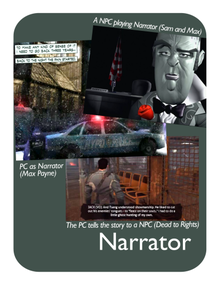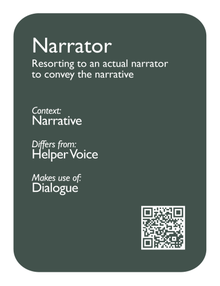Difference between revisions of "Narrator"
From SoundInGames.com - Sound Design in Games
ValterAlves (Talk | contribs) m |
ValterAlves (Talk | contribs) m |
||
| Line 12: | Line 12: | ||
| v20rel-tag2=Differs from:<br> | | v20rel-tag2=Differs from:<br> | ||
| v20rel2=[[Helper Voice]]<br> | | v20rel2=[[Helper Voice]]<br> | ||
| − | | v20rel-tag3= | + | | v20rel-tag3=Makes use of:<br> |
| v20rel3=[[Dialogue]]<br> | | v20rel3=[[Dialogue]]<br> | ||
Revision as of 18:10, 16 July 2012

|

| |
| The card's front face | The card's back face |
Contents
Synopsis
| Resorting to an actual narrator to convey the narrative. |
Relationships
Context:
Narrative ![]() .
.
Differs from:
Helper Voice ![]() .
.
Makes use of:
Dialogue ![]() .
.
Description
One possible way to convey the game's Narrative is to include a Narrator, in the literary and filmic sense. Options for the behaviour of the Narrator resemble those from film practice.
It is worth noting that, although Narrator and Helper Voice occasionally share form, they address distinctive explorations.
Examples
Call of Duty: World at War: Cutscenes between levels are narrated.






